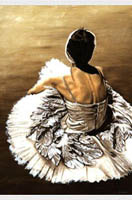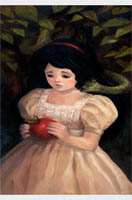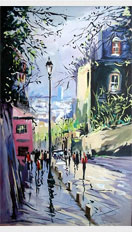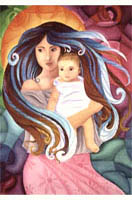- Oil Painting »
- Piet Mondrian
Piet Mondrian
Piet Mondrian (March 7, 1872 – February 1, 1944) was a Dutch painter and an important contributor to the De Stijl art movement, which was founded by Theo van Doesburg. Despite being well-known, often-parodied, and even trivialized, Mondrian's paintings exhibit a complexity that belie their apparent simplicity. He is best known for his non-representational paintings consisting of rectangular forms of red, yellow, blue, or black, separated by thick, black, rectilinear lines. They are the result of a stylistic evolution that occurred over the course of nearly thirty years, and which continued beyond that point to the end of his life.
Netherlands 1872 - 1912
Born at Amersfoort in The Netherlands as Pieter Cornelis Mondriaan, he began his career as a teacher in primary education, but while teaching he also practiced painting. Most of his work from this period is naturalistic or impressionistic, consisting largely of landscapes. These pastoral images of his native Holland depict windmills, fields, and rivers, initially in the Dutch Impressionist manner of The Hague School, and then using a variety of styles and techniques documenting his search for a personal voice. These paintings are most definitely representational, and illustrate the influence that various artistic movements had on Mondrian, including pointillism and the vivid colors of fauvism.
On display in The Hague's Gemeentemuseum is a number of paintings from this period, including such post-impressionist works as "The Red Mill" and "Trees in Moonlight". One 1908 painting called "Avond" ("Evening"), a scene of haystacks in a field at dusk, even augurs future developments by using a palette consisting almost entirely of red, yellow, and blue. Although it is in no sense abstract, "Avond" is the earliest of Mondrian's works to emphasize the primary colors.
The earliest paintings that show an inkling of the abstraction to come are a series of canvases dating from 1905 to 1908, which depict dim scenes of indistinct trees and houses with reflections in still water that make them appear almost like Rorschach ink blots. However, although the end result leads the viewer to begin emphasizing the forms over the content, these paintings are still firmly rooted in nature, and it is only the knowledge of Mondriaan's later achievements that leads one to search for the roots of his future abstraction in these works.
Mondriaan's art was always intimately related to his spiritual and philosophical studies. In 1908, he became interested in the theosophical movement launched by Helena Petrovna Blavatsky in the late 19th century. Blavatsky believed that it was possible to attain a knowledge of nature more profound than that provided by empirical means, and much of Mondriaan's work for the rest of his life was inspired by his search for that spiritual knowledge.
Mondriaan and his later work were deeply influenced by the Moderne Kunstkring exhibition of Cubism held in Amsterdam in 1911. His search for simplification is shown in two versions of "stilleven met gemberpot" ("still life with ginger pot"). The 1911 version[1] is cubist, in the 1912 version[2] it is reduced to a round shape with triangles and rectangles.
Paris 1912 - 1914
In 1912, Mondrian moved to Paris and changed his name (dropping an 'a' from Mondriaan) to emphasize his departure from life in the artistic backwater of Holland. From this point on, he signed his work as "Mondrian"[3]. While in Paris, the influence of the cubism of Picasso and Braque appeared almost immediately in Mondrian's work. Paintings such as "The Sea" (1912) and his various studies of trees from that year still contain a measure of representation, but they are increasingly dominated by the geometric shapes and interlocking planes commonly found in cubism. However, while Mondrian was eager to absorb the cubist influence into his work, it seems clear that he saw cubism as a road leading to an end, rather than an end in itself.
Netherlands 1914 - 1919
Unlike the cubists, Mondrian was still attempting to reconcile his painting with his spiritual pursuits, and in 1913, he began to fuse his art and his theosophical studies into a theory that signaled his final break from representational painting. World War I began while Mondrian was visiting home in 1914, and he was forced to remain in the Netherlands for the duration of the conflict. During this period, Mondrian stayed at the Laren artist's colony, there meeting Bart van der Leck and Theo van Doesburg, both artists undergoing their own personal journeys toward abstraction at the time. Van der Leck's use of only primary colors in his art greatly influenced Mondrian. With Van Doesburg, Mondrian founded "De Stijl" (The Style), a periodical in which he published his first essays defining his theory, for which he adopted the term neoplasticism.







